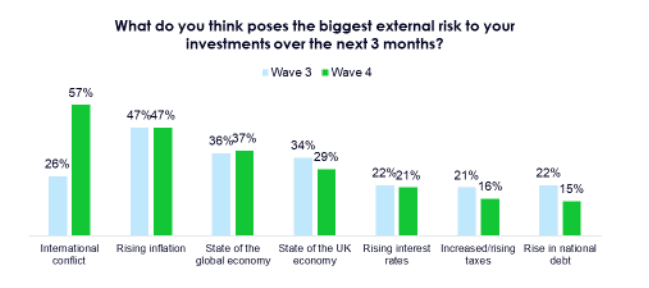- 57% of DIY investors say international conflict poses the biggest external risk to investments, up from 26% in the fourth quarter of 2021.
- The majority of retail investors surveyed remain confident in their portfolios (73%), with only 41% repositioning in light of these risks.
- Home is where the heart is, 51% of DIY investors have exposure to domestic equities compared to the 28% invested in foreign equities.
- Preference for domestic equities is driven by respondents’ knowledge of domestic markets (45%), overseas markets being too risky due to political instabilities and currency fluctuations (21%).
April 12, 2022: International conflict has surged to the top of DIY investors’ risk list overtaking inflation as Russia’s invasion of Ukraine sent shockwaves through global financial markets.
According to the latest ‘Retail Investor Beat’ from social investment network eToro, 57% of respondents said international conflict poses the biggest external risk to their investments, up from 26% in the fourth quarter of 2021.
47% of investors remain concerned about inflation’s impact on investments, followed by the state of the global economy (37%) and rising interest rates (21%).

eToro’s Global Markets Strategist, Ben Laidler, comments: “The tragic events in Ukraine are a triple-hit to investors with its toxic combination of greater market uncertainty, higher inflation from soaring commodity prices, and lower economic growth from sanctions disruption.”
While a surge in volatility is a difficult environment for any investor to navigate, the majority of retail investors surveyed remain confident in their portfolios (73%), with only 41% repositioning in light of these risks and more than half of respondents (52%) planning to consistently invest the same amount of money over the next 12 months.
“History shows geopolitics often does not have a long lasting impact on global markets. Fundamentals remain solid, with company profits rising, economies reopening after the pandemic, company stock market valuations now cheaper, and markets now fully expecting central banks to raise interest rates significantly,” Laidler adds.
“The more risk-tolerant, which includes many younger investors with significant time to retirement, should remember the investment maxim ‘be greedy when others are fearful’, which means investors can often benefit from contrarian thinking at times of crisis.”
DIY investors’ ability to look ahead and beyond short-term volatility is seen through their commitment to the long term investment themes they are considering. 38% see opportunities in clean technology (37% last quarter), digital transformation (32%, down from 33%), cryptoassets and digital payments (26%, up from 22%), robotics and automation (25%, up from 24%) and ageing populations (24%, up from 23%).
eToro US Investment Analyst, Callie Cox, comments: “When markets are volatile and the world is going through such an awful humanitarian crisis, it may be worth taking a step back to consider what is emotional and what is fundamental. If you take one more step back, you will see that society is resilient. The markets have shown time and time again their ability to recover.
“The lack of repositioning among DIY portfolios suggests some risk-averse investors are beginning to consider dollar-cost averaging, and invest a fixed amount on a regular basis into the markets to help smooth high volatility and ensure they do not miss an eventual recovery.”
Growing geopolitical tensions has caused some retail investors to favour domestic markets over overseas investments and take solace in assets they are more familiar with. 51% of respondents are currently investing in domestic equities, compared to 28% in foreign equities. When asked what the biggest reason they prefer domestics equities, 45% of respondents said they understand domestic markets better, 21% believing overseas markets are too risky due to political instabilities and currency fluctuations.
“With investment and economic risks seen as high, some are looking to increase diversification. For the 28% of respondents currently invested in foreign equities, they view this allocation as a way to increase portfolio diversification (35%) and gain exposure to different sectors like US tech (12%),” Laidler concludes.
Other findings include:
- Enthusiasm around cryptoassets remained strong this quarter. 39% of respondents said bitcoin presents the best investment buying opportunity, up from 36% last quarter. This was followed by ether (19%), litecoin (11%), dogecoin (10%), solana (7%), shiba inu (7%), cardano (7%), XRP (6%), dash (6%) and polkadot (5%).
- This enthusiasm is spurred on by the belief it is a transformative asset class (28%), can provide strong returns (27%), store of value (23%) and a hedge against inflation (17%).
- The US S&P 500 was the index seen as most likely to rally in the next 12 months (25%), followed by the Chinese Shanghai Stock Exchange (21%), Japanese Nikkei 225 (19%), FTSE100 (18%) and the European Euronext (17%).
- 40% believe precious metals are the commodity which presents the best investment buying opportunity, followed by oil (34%) and agricultural products (31%).
- Energy has risen to be the sector 35% of respondents feel presents the best investment buying opportunity over the next 3 months. This is followed by technology (30%) and healthcare (24%). Last quarter, 37% of respondents considered technology as the primary investment opportunity, followed by healthcare (34%) and energy (26%).
Source: https://www.etoro.com/news-and-analysis/etoro-updates/rib-april-22/